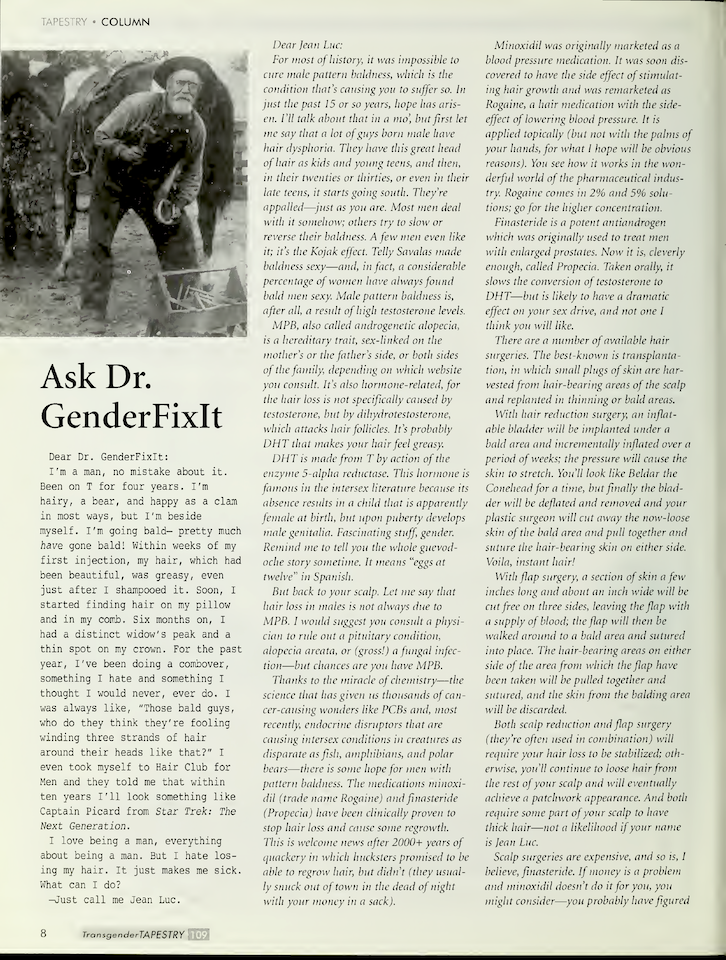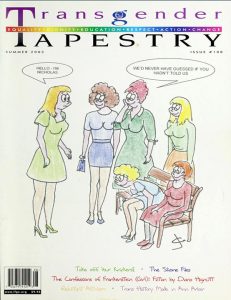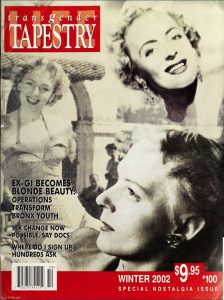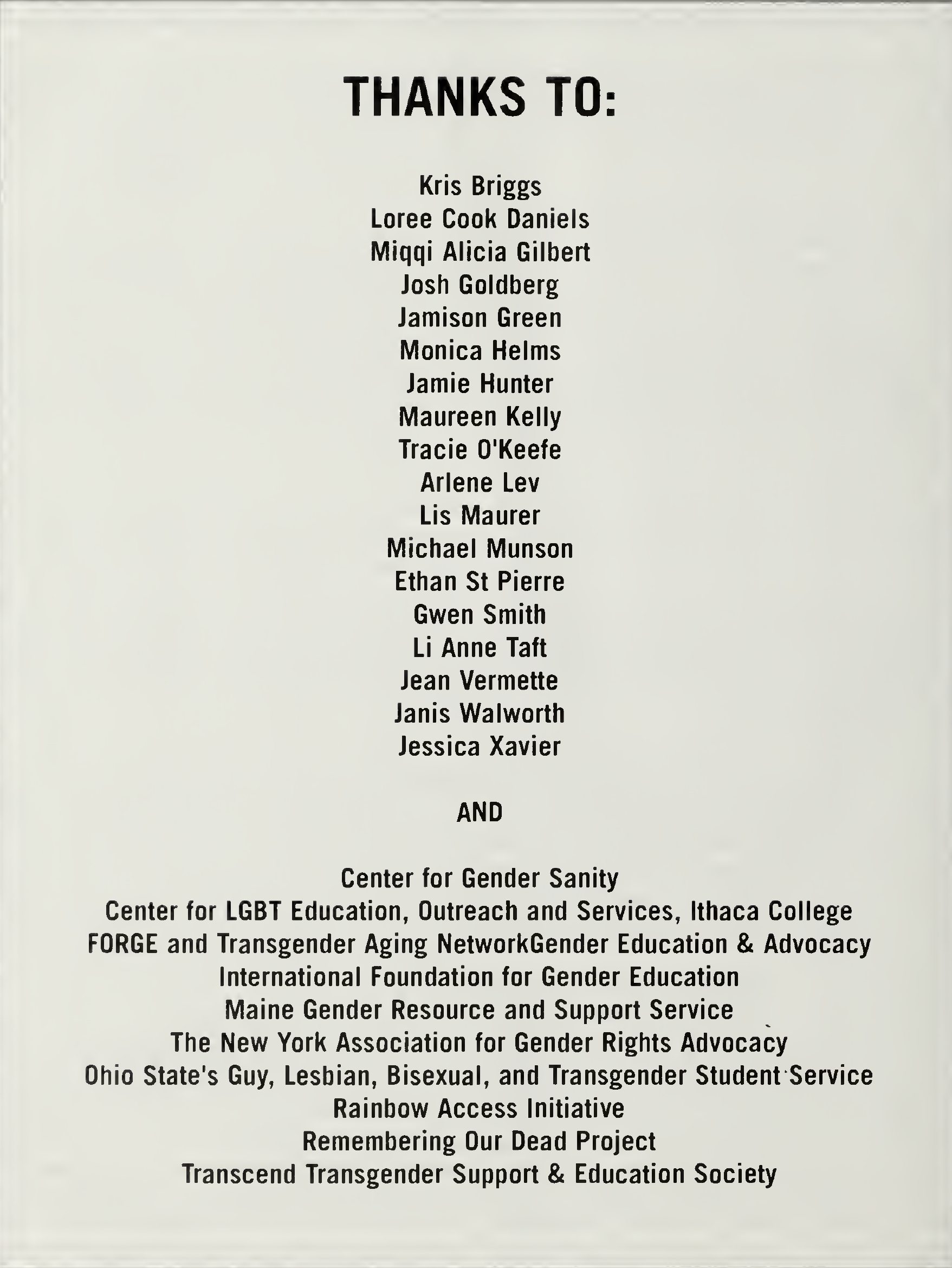A History of Tapestry Magazine Part III
Note: Part I of this series about the late trans magazine Tapestry followed its timeline across its thirty-year lifespan. Part II discussed the development of transgender personal ads in general and their trajectory in Tapestry in particular. In Part II, I discuss my personal experience as editor-in-chief.
To view most issues of Tapestry’s 115-issue run, go here.
My Personal Experience as Editor-in-Chief
I became editor-in-chief of Transgender Tapestry with issue number 89 (Spring, 2000). My last issue was number 110 (1996.) Number 111, with editorship credited to the IFGE Executive Director, consisted largely of material I had curated.
As I noted in Part I of this series, I was happy when the IFGE board offered me the position of editor. I would be able to work from home, which was essential, as I lived in Georgia and had a full-time position with state government, and the IFGE officers were on the outskirts of Boston.
I had considerable history as an editor, and so was undaunted by the task ahead of me. I was excited to be educating and entertaining trans people—and I was thrilled that this was to be a paying gig, my first and only in the trans community. I had just purchased my first house and had been renovating it in installments, working from paycheck to paycheck. My salary as editor certainly sped things up!
Contributors
Let me say I certainly wasn’t the only person involved in the production of issues 89 through 109 of Transgender Tapestry. Donna Cartwright served as Associate Editor from issues 91 through 101. Contributing Editors were, in order of appearance, Miqqi Alicia Gilbert, Gianna Israel, Gwendolyn Smith, Andrew Matzner, kari edwards, and Monica Helms. Tapestry’s official photographer was, as she had been since the mid-1980s, Mariette Pathy Allen. Most of the classic Tapestry photo covers feature her artistry. Art directors were, sequentially, Larissa Glasser, Jessica Johnson, Nicole Veneto, Kim Titcomb, and Dave Bryant. Columnists were Miqqi Alicia Gilbert, Monica Helms, Kate Bornstein and Barbara Carrellas, Ari Lev, Li Anne Taft, and Judy Osborne. During his tenure as IFGE Board Chair, Moonhawk River Stone regularly submitted columns. I now freely admit, hopefully absolved of my guilt by the passage of time, of creating, in issue 108, the fortunately short-lived advice columnist Dr. GenderFixIt. I wrote the questions, I wrote the answers, and I have no idea where I found that photo!
And then there were the many, many contributors. I published content by, among others, Mariette Pathy Allen, Kate Bornstein and Barbara Carrellas, Holly Boswell, Miqqi Alicia Gilbert, Michele Kammerer, Arlene Istar Lev, Gordene MacKenzie, Shannon Minter, Nancy Nangeroni, Virginia Prince, Marisa Richmond, Katrina Rose, Gwendolyn Ann Smith, and David Steinberg—and that’s in just the first two issues! There are far too many content providers to list here, but know, if you were one, or if you were involved in any way in the production of the magazine, you have my respect and admiration and thanks.
If I left anyone out of this litany, please accept my most profound apology.
Content: Controversy and Equilibrium
As editor, I did my best to maintain a balance of sorts. I knew that no matter what I might do, some crossdressers (1) would complain that there was too much content devoted to transsexualism and some transsexuals (2) would complain that too much content was devoted to crossdressing. I stated as much in an editorial in issue 89. I like to think I did manage some sort of balance.
I made it clear at the outset that Tapestry was about diversity—or at least would be while under my control:
As the title suggests, this magazine is about transgender—that is, transgressively gendered people, people who have traditionally been called crossdressers, drag queens, and transsexuals. But I have a larger audience in mind. I would like Transgender Tapestry to be of interest to anyone who has ever questioned any aspect of their gender role, from desiring a job that isn’t “gender appropriate” to being ridiculed for wearing hair that’s “too short” or “too long” to having a voice that’s “too high” or “too low” in pitch to loving someone of the “wrong” gender (3).
To reinforce this point, I reprinted, in issue 98, Holly Boswell’s enormously influential 1991 article “The Transgender Alternative,” which had been published initially and simultaneously in both Tapestry and my own Chrysalis Quarterly (4). In the piece, Holly solidified what many in the then-forming trans community had been thinking and talking about—a middle ground between the two acknowledged genders. In essence, Holly gave us permission to identify in any way we wished rather than conforming to the two niches then available to us: crossdresser or transsexual.
I wasn’t interested in being noncontroversial. (5) I did things previous editors had mostly avoided, including spotlighting those I thought were in the wrong. For instance, in my initial issue, I took to task S.P.I.C.E., Tri-Ess’ conference for wives and female partners, for inviting Virginia Prince to give a keynote at their 1999 conference and then requiring her to dress in male drag. To her credit, Virginia, who had been living as a woman for more than 30 years and who had a message for the other women present, swallowed her pride and appeared as the long-defunct Charles. In an editorial that prefaced the text of her keynote, I wrote, “In appearance, Virginia, at 87 years of age, is but another elderly woman. It’s very difficult to see any ‘Charles’ there.”
As soon as she arrived at the hotel, Virginia told me, she was whisked into a suite and transformed into a not-very-male-looking Charles Prince. It was every crossdresser’s dream come true, but in reverse—a forced transformation by domineering women. Virginia was not allowed to reappear until she was ready to leave the conference to return home. (6)
Here’s an excerpt from her speech:
The border between girl and woman is generally accepted as being age eighteen. I’ve been a woman for 32 years; 18 and 32 makes 50. How many of you women are under 50 years of age? Quite a few. That means that I’ve been a woman longer than many of you. (7)
With issue 92, I created a section of the magazine called The Journal and began with a discussion of the controversial and prejudicial concept of autogynephilia. In issue 93, in 2001, I and Associate Editor Donna Cartwright skewered Rikki Ann Wilchins for hijacking the nonprofit trans organization GenderPac. (8) Issue 95 launched a lively discussion of passing. It began with Miqqi Gilbert’s column “The Politics of Passing” on page 15 and moved to the Journal, where, in an article called “The Transgender Revolution: Our Historical Reemergence,” the always prescient Holly Boswell wrote:
Passing prevents us from showing who we fully are. And as we persist in passing, we must maintain elaborate webs of secrets and lies. As we project ourselves through what Sandra Bern calls “the lenses of gender,” we may come to feel others are seeing less instead of more of our essence. (9)
Holly, and Jessica Xavier, in the same issue, squarely addressed the issue of passing as privilege at a time when privilege was rarely discussed outside of feminist and African American academia. That set off a lively debate!
The Journal continued only through issue 100—but Tapestry continued to cover controversial topics. In issue 103, Christine Beatty took on J. Michael Bailey’s intellectually dishonest book The Man Who Would be Queen. Issue 104 contained five pages on the Bailey controversy with articles by Marisa Richmond and Katrina Rose, and two one-page editorials written by yours truly. Issue 108 addressed at considerable length the dangers of injected silicone.
Twice under my editorship, Tapestry came to the defense of people who were rejected because of their gender presentations. The first was Christine Hochberg, who I expect many of my readers might know. Dainna Cicotello’s piece “The Clown in Our Midst” appeared in issue 94; the cover of issue 101 featured a crossdresser who was ignored or challenged at a number of gender conferences due to the presence of facial hair. I put her on the cover as a sort of fuck you to the more narrow-minded in our community. She had a reason for keeping that facial hair.
Of course, most of the content of Tapestry wasn’t meant to be controversial and wouldn’t have been considered so by anyone other than a bigot. Alas, as much as I’d love to detail that content, there’s no room to list here, much less describe, the many wonderful articles and features that appeared in the issues I edited.
Content: Covers
The first eleven issues of Tapestry contained text only; there weren’t covers in any actual sense, just the first page of a typed newsletter. The first page of issue 12 (1979) contained a drawn image of the Tiffany Club of New England’s logo: a long-stemmed rose. Small photos and illustrations appeared on occasion afterward. Issue 33, in 1981, was the first with a magazine-style cover, and issue 49 (1986) was the first with a full-page, four-color portrait, marking Tapestry as a genuine magazine. The photograph was taken by, no surprise here, Mariette Pathy Allen. The subject was a transgender woman. The next fourteen covers also featured individual trans women.
Issue 65 (1993) marked the first appearance of a transgender man on the cover. The impact was considerably lessened by the transgender woman who posed alongside him. Issues 68 (1994) and 80 (1997) featured similar covers. The first cover that featured a nonbinary person without an accompanying woman graced issue 85 in 1998. Who was the subject? None other than Leslie Feinberg. Leslie, while quite masculine, never quite identified as a man, and moved comfortably into a nonbinary identification as that option became acknowledged.
The first cover that featured a trans man was on issue 94 (2001), which was edited by—guess who? IFGE Board Chair, reverend, and therapist Moonhawk River Stone was the subject.
I like pushing envelopes, and I certainly did so with the covers. Issue 98 (2002) featured attorney Jennifer Levi of GLAD Legal Advocates and Defenders. At the time, Jennifer was presenting as female. And so that cover was the first, as I figure it, to feature someone manifesting with the gender of their birth.
Issue 105 (2004) was the first to feature trans young people. The cover of issue 106 (also 2004) was a rather disturbing drawing that reflected the body image of transman Coda Stone. More images by Coda appeared inside. That cover marked the only time the IFGE board manifested concern about my decisions as editor or the content of the magazine. It truly was a disturbing cover—that was the point—and I’m glad I pressed the issue.
The cover of issue 108 (2005) featured a full-page cartoon by Christine-Jane Wilson; her illustrated article appeared inside.
I’m not saying I initiated all of these covers, but I certainly approved them and was happy to move away from a decades-long sequence of cover girls.
Content: Humor
I have a well-developed sense of humor, and I love to manifest it in print. During my 20-issue run, humor was evident throughout the magazine; one never knew when a snarky comment might pop up. I particularly delighted in the back-and-forth with columnist Monica Helms. I have to admit she started it, but I was happy to jump into the fray. Monica made her debut in issue 92. In her column in issue 93, she poked me gently, getting my attention. She dropped my name again in issue 94, but again in a minor way, so I patiently waited for an opportunity to pounce. That came in issue 98.
All is quiet here in the 60-story Transgender Tapestry building in beautiful downtown Atlanta. Dallas’s office takes up the entire 56th floor. I understand she is currently enjoying a marathon film festival on her entertainment system, which takes up an entire wall of her office….
My new office is on the 45th floor. Yes! I have an office now! Seems I was promoted to… to…? What the heck was I promoted to? Oh, well. At least Dallas doubled my salary once again. That makes 17 times in one year. I don’t see an actual check, because Dallas says it’s being direct-deposited to my checking account. She takes good care of us….
Dallas must have really enjoyed “Lord of the Rings,” because she’s given various transgender people wizard names. She insists we now refer to her as Dallas the Denim…. And what does she call me? “Monica the Maroon.” Yep, that’s right. Gee, thanks, DD. I guess all the good colors were already taken (Uh, the word I used wasn’t maroon, Monica, but you’re close—Dallas).
It was nonstop banter after that, Monica in plain text and me in italics.
I happily called bullshit on a series of letters previous editors had published over the years, all of which were pure fancy and had clearly been written by the same individual (I learned IFGE staff had a pet name for him: Ivan.) (10) But I had the most fun with my From the Editor page. The columns were serious stuff, but I ran a different photo of me in almost every issue. Dallas as a young boy. Dallas as a young woman. Dallas playing the guitar. Four images of Dallas taken in a photo booth. Dallas at a lake. Dallas pontificating at a party. Pensive Dallas. Dallas with facial hair. Dallas trying on a wig. Dallas at the Grand Ole Opry. Dallas sitting on the hood of her 1954 Chevy. Glamour Dallas. Few people understood it, but I was having a hoot!
Another Favorite Issue
I noted in Part I of this series that issue 100 is the one I feel best demonstrated my vision for Tapestry. I loved the bleeds and the way related sections of text were interwoven with images by art director Jessica Johnson. But I have to say issue 101 is also a favorite. It demonstrated something called distributed gender education, which was originated by activist Jessica Xavier. Here’s the back story…
In the mid nineties, two things happened that set me to pondering the fate of trans brick-and-mortar educational nonprofits. The first was the appearance of trans political organizations. People seemed to love to throw money at them, and I realized that would be to the detriment of educational organizations that helped individual trans people. The second was the public availability of the internet, which by 1993 I knew would cause a fundamental change in the way information was distributed. The established way was to print flyers, handbooks, newsletters, magazines, and books on paper and distribute them through commercial networks via the mail. This required ink and paper and expenditures for layout and printing and some sort of headquarters to house staff and computers and the like (which is why I called this the brick and mortar model). The internet promised the ability to, for all practical purposes, send an unlimited amount of information to an unlimited number of people instantaneously and for almost no cost.
I had already noted that the quality of the information distributed by many local trans organizations was as good at or in some cases exceeded some of the national nonprofits (I’m looking at you, IFGE!). Jessica’s distributed gender education model was just this: perhaps, instead of generating all of the information they distributed, nationals would serve their constituency better by being a clearinghouse of sorts, choosing educational material from every source, and then distributing it. I wrote about this in a series of articles in AEGIS News. Tapestry 101 was a practical demonstration of this. The issue included a tear-out section with 34 pages that could be removed from the magazine, duplicated, and distributed—by anyone! The content pretty much covered the waterfront. It included, among other things, Harry Benjamin’s scale of gender variance, at least three glossaries, a flyer about gender-variant people in the criminal justice system, another about affirming gender identity in the workplace, suggestions for how to give effective transgender 101 presentations to the public, and a checklist for transgender inclusion. See the attached image for a list of the people and organizations who provided the source material for the tear-out section.
Jessica Xavier, if you are reading this, thank you for coming up with the distributed gender education model. And Jessica Johnson, thanks for laying out the issue so beautifully.
My Exit
“Damn,” I told myself. “I’m good at this!” I was having a grand time and my house was looking better and better, but IFGE was coming apart. It was, in fact, being systematically dismantled by its last Executive Director. I’ve never figured out why she destroyed the organization, (12) but she did, and the effect on the magazine was inevitable. She somehow lost Tapestry’s distribution deal, so we were producing far fewer copies of each issue and the magazine was generating less income than it produced. Issues became less frequent, and my salary came later and later.
I was frustrated by the executive director’s continual refusal to allow me to publish an editorial about the disappearance of the largest collection of transgender material in existence, but I held my peace—for years. (13) The director was eager for me to resign, but didn’t dare dismiss me without cause, and I was giving her no cause. Eventually, however, she inserted a piece into what would have been my twenty-first issue without my knowledge or permission. It was in fact an article I had commissioned and then refused because before giving it to Tapestry as promised, the author had published it on her website, which was one of the internet’s most popular trans sites. The article would be appearing months after everyone had read it, and it made little sense to print it. The author wasn’t happy and made that known, but I didn’t give a flip. However, when the director told me she planned to publish the piece over my objections, it was clear to me she was doing it in pure appeasement. I couldn’t have that, as it went against every tenet of journalism. You just can’t publish things just to placate someone. I would not be associated with the denigration of a magazine with a fine reputation and a proud history.
That was the triggering event for my resignation, but it was IFGE’s willful withholding of critical information from the very people they were sworn to serve—i.e., withholding an editorial making readers aware that a significant portion of transgender history was in the wind, whereabouts unknown—that was the cause. I told the staff and board I could not be associated with a magazine that had lost its integrity, and tendered my resignation. I’m sure the E.D. was thrilled.
Tapestry limped along for a few more issues, and ended in 2008 with number 115. Then it was gone, as were the IFGE offices, its conference, its bookstore, and the more than $100,000 that was in the “we’ll never touch it” Winslow Street Endowment Fund.
I’ve told this story before, and I’ve provided links for those who might wish to read the full version. I’ve included this section because it was the concluding part of my arc as editor of one of the finest transgender magazines ever.
Do I miss Transgender Tapestry? Yes, I do. Do I miss being editor? Yes, I do. Am I sad because it’s gone? Yes, I am, but not for IFGE’s sake. I’m sad because its listing of services was instrumental in my life and in the lives of thousands of other trans people who found there the support they needed to make competent decisions about their lives. That’s all I ever really wanted, and all I ever wanted for others—that we be able to get information. It is, in fact, the reason I became an activist. I grew up with almost no information about what was going on with me. I don’t want anyone else to have that experience.
Notes
1 That was the term then in use.
2 Ditto.
3 Denny, Dallas. (2009, Spring). A Word from the Editor. Transgender Tapestry, 89, p. 5.
4 Boswell, Holly. (2000, Spring). The transgender alternative. Transgender Tapestry, 98, pp. 15-17.
5 I of course took direction from the IFGE board, which was in fact quite hands off about the magazine, and from Denise, who, with exceptions I will soon mention, did not constrain me.
6 See Virginia’s Ordeal, Transgender Tapestry, 89 (2000), pp. 21-22
7 Prince, Virginia. S.P.I.C.E. Keynote Talk. Transgender Tapestry, 89 (2000), p. 21.
8 GenderPAC’s Implosion, Tapestry 93 (Spring, 2001), 7 (me); We’re From GenderPAC; We’re Here to Help You, 13-15 (also me); Whither GenderPAC, 56-58) (Donna Cartwright).
9 Boswell, Holly. (2000, Fall). The transgender revolution: Our historical reemergence. Transgender Tapestry, 95, pp. 19-22.
10 Ivan, You’re Busted, (2000). Transgender Tapestry, 90, pp. 9-10.
11 AEGIS News 6, January, 1996; 7, April, 1996; 8, September, 1996; 9, December, 1996; and 13, April, 1998. http://dallasdenny.com/Writing/2013/04/11/aegis-news-1994-1998/. Accessed 5 December, 2022.
12 My personal theory is she wanted to go to Washington, D.C. and play politics and be like Mara Keisling. Not the wisest direction for a 501(c)(3) educational nonprofit. We have all seen the consequences.
13 After my resignation, I published the censored editorial on my website. See Denny, Dallas. (2011, 1 November). Where is our history? (Censored Editorial, 2004). http://dallasdenny.com/Writing/2011/11/01/where-is-our-history-censored-editorial-2004/. By then the huge transgender collection, which went missing for some years, had been located and saved. Hats off to Aaron Devor for making that happen! See Denny, Dallas. (2011, 4 November). History Mystery Solved. Chrysalis Quarterly Journal. http://dallasdenny.com/Chrysalis/2011/11/04/history-mystery-solved/. Accessed 4 December, 2022.
14 Denny, Dallas. (2011, 19 September). Deceit and Betrayal at IFGE. http://dallasdenny.com/Chrysalis/2011/09/19/deceit-and-betrayal-at-ifge/. Accessed 4 December, 2022. Denny, Dallas. (2011, 19 September). Open letter to IFGE. Chrysalis Quarterly Journal. http://dallasdenny.com/Chrysalis/2011/09/19/open-letter-to-ifge/. Accessed 4 December, 2022.
Category: History, Transgender History









